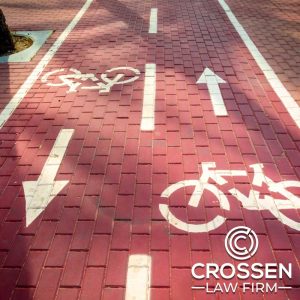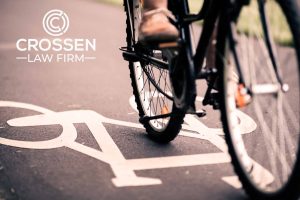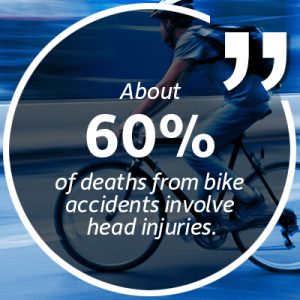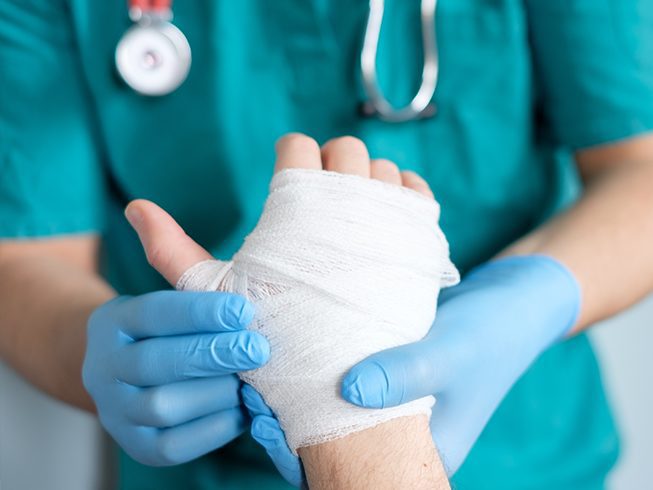Indianapolis Bicycle Accident Lawyers

If you’ve been injured in an Indianapolis bicycle accident, you may be eligible for compensation if your bike accident was caused by a motor vehicle operator’s error. The legal system is complex, so not all bicycle crashes can get compensation. Our Indianapolis bicycle accident attorneys can help you get the compensation you deserve.
Contact the bicycle accident lawyers at Crossen Law Firm today at 317-401-826.
Five Steps to Protecting Your Rights After a Bicycle Accident in Indianapolis
1. Understand Compensation for Bicycle Accident Cases

Bike accident victims can be compensated for their medical bills, pain and suffering, mental anguish and emotional damage, property damage, lost wages, and future damages.
In many cases involving a vehicle and bicycle, the vehicle driver can be held liable. Compensation can be sought by turning to the driver’s insurance company for coverage. If driving is part of the driver’s job and he or she was working at the time of the accident, the driver’s employer may also be liable.
Bicycle accident victims should not have to bear medical expenses, pain and suffering, lost income, and other losses from catastrophic injuries on their own. Bicycle accident lawyers can navigate Indiana’s complex bike law to aggressively pursue compensation for you for bicycle-related injuries.
2. Partnering with an Indianapolis Personal Injury Attorney or Bicycle Attorney
Determining liability in a bicycle accident case is not always straightforward. Recollection of events can blur, and opposing stories can result. Injury victims trying to investigate and make a claim on their own face substantial challenges.
Your bicycle lawyers and their legal team may visit the accident scene and use photo and video evidence, eyewitness statements, and police and medical reports to build your case. Bicycle accident lawyers can also help calculate total expected losses and ensure that medical bills for treatment and examination are covered.
Bicycle attorneys will engage in good-faith negotiations to reach a settlement with the other party’s insurance company. Your bicycle lawyer works to recover compensation for bicycle and car accident victims, but they can also take cases to trial if a victim cannot otherwise receive fair compensation.
Some bike accident victims attempt to handle their own personal injury cases without assistance from an Indiana bike accident lawyer. They often believe that filing a claim will be simple and that they will save money by not involving a personal injury attorney. However, injured bicyclists and victims who pursue their cases alone often end up with a denied insurance claim or lower settlement than they are owed. It’s best to engage a firm of bicycle accident lawyers with a proven track record of representing injured cyclists.
3. Avoiding Fault as a Cyclist

Cars are significantly larger than bikes, so bicyclists — not drivers — are usually the ones injured in accidents between bicycles and automobiles. However, determining fault in bicycle crashes does not depend on the extent, or lack, of injuries. The party that acted negligently would ultimately be held at fault.
Indiana law requires that bicyclists obey traffic laws. Cyclists must adhere to stop signs and traffic lights and also properly yield to oncoming and existing traffic. Bikers must also ride in the same direction as traffic and signal when turning.
Even though vehicles and bicycles share many of the same responsibilities and rules for safe operation, bicyclists are still at greater risk when accidents occur. So, always ride safely and be aware of your surroundings.
4. Understanding Shared Fault
It is possible for more than one party to contribute to the cause of a bicycle accident. Any negligence on the part of the bicyclist could be used to place a bicycle accident victim as partially at fault for an accident.
Contributory fault, which refers to the contributions that a party made to an injury or accident, can make injury and car insurance claims more complicated. Indiana legal code states that injured claimants deemed partially responsible for their own wrongful death or injuries may still be entitled to financial compensation for their losses. In cases involving vehicles and bicycles, if both the driver’s and the bicyclist’s actions contributed to an accident, a personal injury claim would be subject to comparative negligence laws.
It is, therefore, important to promptly connect with Indiana bicycle accident lawyers as well as your insurance company in order to help ensure a fair case and a free case evaluation.
5. Deadline for Your Bicycle Accident Lawyer to File a Claim
States follow a statute of limitations for various types of bicycle accident cases, too, which impart strict deadlines for injury victims to pursue compensation in the form of a lawsuit. Not every claim made after a bicycle accident must become a lawsuit; however, it is important to realize that deadlines are in place.
Indiana bike law includes a two-year statute of limitations to file a lawsuit over a bicycle accident injury. The two-year window starts from the date when the bicycle accident occurred.
It is technically possible to file a suit after the two-year statute has passed, but a judge could likely dismiss the case. While two years might seem lengthy, contacting an Indiana personal injury attorney as soon as you can following a bicycle accident is best. Bike law firms will be familiar with the time limits for all claims.
The more time that is granted to investigate a case and possibly prepare a lawsuit, the better. Further, as time passes, people’s recollections of an accident and other key evidence can become lost or compromised. While your focus should be on recovery following a bicycle accident, acting fast to partner with an experienced Indiana attorney and legal team will benefit your case and eventual outcomes.
Common Causes of Bike Accidents
Dangerous Driving
- Experienced bicyclists are no match for the speed and unpredictability of motor vehicles. Even if you obey all bicycling traffic laws, cars are only as safe as the drivers behind the wheel. Some drivers can be careless, negligent, or even aggressive toward bicyclists.
- Some of the most common causes of a bicycle accident by fault of drivers include speeding, driving at night or at times of low visibility, driving under the influence of drugs or alcohol, and distracted driving (not paying attention when behind the wheel).
- Motorists can also cause a bike accident by passing a bicyclist too closely or even attempting to run a biker off the road can cause a bicycle crash, too.
- Finally, even when parked, motorists should open their car door carefully, as failing to see a bicyclist can result in a serious accident. A carelessly opened car door can cause multiple injuries.
Safe and Unsafe Cycling
- When bicycles and motor vehicles collide, bicyclists almost always suffer worse injuries, including serious injuries that can be life-threatening. Bicyclists are much lighter than cars and don’t have as much protection.
- It is important that bicyclists still ride responsibly and follow traffic rules. Failing to do so can cause a bike crash, with a cyclist’s unsafe practices as a contributing factor.
- Common causes of accidents and crashes on the part of bicyclists include failing to yield to the right of way, riding during poor visibility or bad weather without using reflective gear, and riding against the traffic flow.
- Indiana bicyclists have a right to use the road as much as other drivers. In fact, bicyclists can legally ride in the center of the lane, although it is recommended to keep to the right side of the lane.
Common Bicycle Crash Injuries
Bicycle falls, accidents, and injuries can happen to riders of any age and experience level. Accidents that involve bicycles and motor vehicles are especially dangerous and can cause severe injuries or death. The difference in size and mass between a bicyclist and even a small automobile is significant. Damage and injuries are almost always worse for the cyclist than for the driver of a car.

All Parts of the Body Are Vulnerable
Certain types of bicycle accident injuries can be common following a collision between a bicycle and an automobile or truck. Head injuries are common among bicycle riders. About 60% of deaths from bike accidents and 30% of emergency department visits related to bike accidents involve head injuries, according to the CDC.
Other common bike crash injuries include:
- Spinal and spinal cord injuries and neck and back injuries
- Fractures to shoulders, arms, wrists, hands, legs, feet, and hips
- Joint dislocations of the knee and shoulder
- Lacerations, scrapes, and road rash (abrasions)
- Strains and sprains to muscles, ligaments, and tendons
- Internal organ injuries
No matter the extent of your own bicycle crash or related injuries, even if the accident appeared mild, it is important to have a qualified medical provider examine you for any injuries or trauma following a bicycling accident.
Medical expenses for procedures to properly diagnose injuries or examine a patient after an accident; expensive diagnostics such as x-rays and other tests and scans are often necessary. More serious injuries can require more medical treatment, hospitalizations, surgeries, physical therapy, counseling, and other services.
Head Injuries and Traumatic Brain Injury

Some collisions leave injured cyclists with a traumatic brain injury (TBI). Damage can be limited to a certain brain area. Bleeding or swelling around the brain can disrupt the oxygen supply.
We Help Injured Cyclists Get The Compensation They Deserve
Contact the Crossen Law Firm and ask for a free consultation to learn more about how we fight for the compensation you are entitled to under bike law.
What to Do After Bicycle Accidents
Bicycle accidents are traumatic experiences that can cause serious injury and property damage. While it can be hard to think clearly immediately after an accident, there are certain steps that you should take to protect your safety, preserve evidence, and strengthen an eventual claim or form of legal action involving the accident.
Taking Action at the Accident Scene

You should seek immediate medical attention for any injuries. If you are able to photograph your injuries, your bicycle, the location, and any other surroundings or details, do so. It is also important to inform a qualified medical professional of your injuries so that there is documentation.
Many steps are similar to actions taken after an automobile accident. Call the police to report your bike accident and exchange information with other motor vehicles, bicyclists, or pedestrians involved. If there were any witnesses, get their contact information.
Strengthening Your Case
As soon as you are able, contact an Indiana personal injury attorney experienced with bicycle accidents to begin reviewing your accident. You should not provide a written statement or sign anything involving your bike accident or details before sharing your case with a bike accident attorney.
Be sure to stay on top of your injuries and any symptoms, following routines and advice prescribed by medical professionals. As you recover, do not post any details about the accident on social media, and save any photographs and statements for only your bicycle accident attorney.
It is also key to protect evidence. Your clothing and any other items damaged in the accident should be preserved for evidence. If your bicycle is damaged, do not fix it or cover up the damage. These materials could be used as evidence for your case. A skilled attorney can determine appropriate evidence for accidents involving bikes, trucks, or another motor vehicle.
Bicycle Safety Tips that Reduce the Chance of Bicycle Accidents
 Know Before You Go
Know Before You Go
Before you set off on your bike ride, you should always put your helmet on first to ensure your safety. Wearing a helmet can reduce bicycle-related head injuries by as much as 80%, according to the CDC. Don’t take the risk.
When riding a bike, your clothing should be bright and reflective, especially if riding at night or at other times of low visibility. You don’t want to blend with the darkness of the night.
Nighttime riders must have a white light on the front of their bikes and a red light on the back that can be seen from 500 feet away to increase visibility to vehicle traffic.
Safe Riding Practices
Bicyclists who know bicycle laws and stick to safe biking habits and practices will significantly reduce their likelihood of becoming an injured cyclist. You already know that you should always wear your helmet, but keep in mind the less common bicycling safety practices as well.
Even though you’re on a bicycle, you are required to follow many of the same traffic rules as cars. For traffic signs, for example, bicyclists should also come to a stop and wait their turn when approaching stop signs. Bicyclists should also stop at red lights and wait for green before proceeding.
Bicyclists have an equal right to the road as other drivers. The City of Indianapolis does require that drivers leave three feet of space between vehicles and bicycles when passing bicyclists.
When bike lanes are available, use them. Cyclists can ride the bike lane and on sidewalks in Indiana; however, they cannot interfere with pedestrians.
As with drivers of other types of transportation, cyclists should never ride when under the influence of drugs or alcohol. In 2017, alcohol was involved in 37% of fatal bike crashes nationwide, according to the U.S. Department of Transportation.
Contact a Crossen Law Bicycle Accident Lawyer Today

Bicycle accidents are unfortunately common. While the injuries and suffering after an accident cannot be undone, the right assistance from a bike accident lawyer can help to make sure you are justly compensated following such a traumatic event.
Contact the Crossen Law Firm at 317-401-8626 and ask for a free consultation from one of our bicycle accident lawyers to learn more about how we can help you with your bicycle accident claim.

-
“Trevor was courteous, professional, fair, and an excellent communicator throughout our entire interaction! Would highly recommend.”
- Hussain -
“What a relief it was that we had someone like Trevor Crossen on our side. Everyone in the office were very pleasant and helpful. We would have been lost if not for him. This is a group that you need to be there when you have to fight for what is right. Automobile accidents are hard enough on you without having to have someone see you through all the paperwork and legal issues. There is no one else I would trust to take us through than Crossen Law Firm they are the best!”
- Bob Taylor -
“Mr. Trevor Crossen has been sìuch a blessing. I was so lost when we first met. He took great care to make sure that I was treated with dignity, he walked me through the whole process from beginning to the end. I had no idea what to expect but he took the time to explain everything and made sure I was treated the way I should be. I would highly recommend Trevor to anyone. The others in the office were so kind and helpful. If you want someone truly on your side Trevor Crossen is the man you need. Thank you all for being there for me.”
- Denise Taylor -
“I honestly don’t know where to start! Trevor is an exceptionable person, he honestly cares for those he works with and his clients! He has completely changed my mind of how lawyers act! He is a man of integrity and I, especially today on thanksgiving, am thankful I chose his law firm to represent me! I highly recommend that you choose Crossen law firm!! Thank you Trevor for all that you’ve done for me and continue to do!”
- Ben Steiner -
“Trevor and His Team Were a "True Guiding Light" for MY Family & I During a Very Difficult and Emotional Time in Our Lives! Thank You Team Crossen”
- Joe A

Why Crossen Law Firm?

Call our office today at (317) 401-8626 to discuss your case.

 317-401-8626
317-401-8626 
 Know Before You Go
Know Before You Go